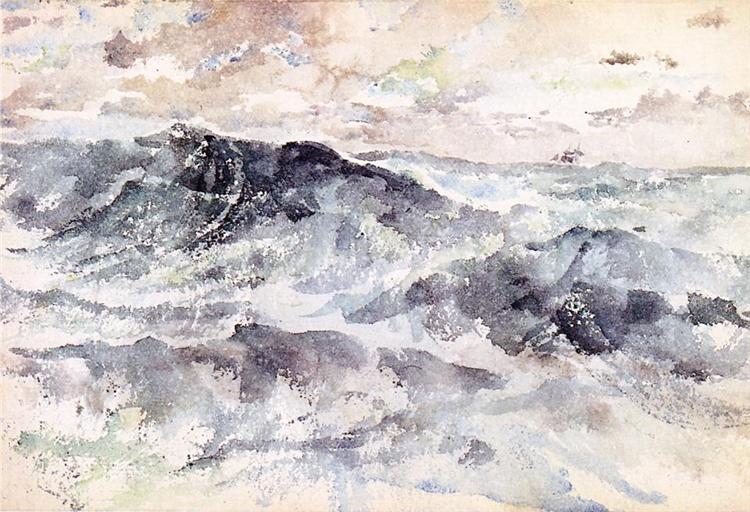Description
In the majestic work "Arrangement in Blue and Silver: The Great Sea" of 1885, James McNeill Whistler reveals its consummated ability to capture the immensity and mystery of the ocean. This painting, from its first brushstrokes to its subtleties of color, is a testimony of Whistler's unique approach to art, which privileges the atmosphere and emotion about detailed and narrative representation.
The composition of "The Great Sea" is a celebration of simplicity and balance. The canvas is dominated by a vast grayish sky that melts harmoniously with the calm waters of the sea, creating an almost perfect symmetry. The horizon line, barely glimpsed, suggests an infinity that escapes from sight and complete understanding, a typically Whistlerian resource to immerse the observer in a melancholic and introspective contemplation.
The use of color in this work is masterful, highlighting predominantly tones of blue and silver. Whistler, influenced by the theory of Japanese art and aesthetic movement, uses a limited palette and a soft brushstroke technique that gives the scene an imperturbable serenity. His choice of colors is not arbitrary; Blue evokes a feeling of tranquility and depth, while silver adds a mystery and freshness nuance, capturing the changing qualities of light on water.
The absence of human figures or concrete narrative elements in this work is remarkable. Instead, Whistler opts for subtle abstraction that invites the viewer to project his own feelings and thoughts in the marine landscape. This technique, far from being a vacuum, allows a more pure, more intimate emotional connection with the work, an achievement that many artists seek but few reach with Whistler's effectiveness.
Interesting is also the title of the work "Arrangement in blue and silver," which suggests an analogy with music. Whistler, indeed, saw his paintings In the same way that a composer sees his symphonies, harmoniously organizing the visual elements as if they were notes in a score. This synesthetic conception of art underlines the deep influence that music and color theory had on their work.
The work is part of the aesthetic movement of the nineteenth century that defended "art for art," a philosophy that Whistler endorsed, rejecting the demands of morality and utility in artistic production. In his other marine works, such as "Nocturne: Blue and Silver - Chelsea" and "Nocturne: Blue and Gold - Old Battersa Bridge," we see a continuation and evolution of these same principles: delicate abstraction, the contemplative use of color and the Atmosphere, and the ability to transform ourselves without explicitly narrating.
To appreciate "arrangement in blue and silver: the great sea" is necessary to get carried away by its peace of mind and allow its subtle nuances to envelop us. Whistler asks us to see beyond the mere landscape and find, in the interaction of blue and silver, a harmony that resonates both the outside world and our own inner state. It is this ability to transform the everyday into a sublime what James McNeill Whistler does one of the masters indisputable of your time.
KUADROS ©, a famous paint on your wall.
Hand-made oil painting reproductions, with the quality of professional artists and the distinctive seal of KUADROS ©.
Art reproduction service with satisfaction guarantee. If you are not completely satisfied with the replica of your painting, we refund your money 100%.

